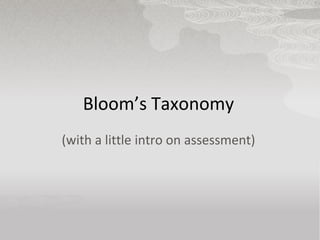
Assessment and bloom’s taxonomy
- 1. Bloom’s Taxonomy (with a little intro on assessment)
- 2. Assessment Provides evidence to instructor and student as to how well the students have learned what we intend them to learn. What we want students to learn and be able to do should guide the choice and design of the assessment.
- 3. Formative Assessment Low stakes assessments for students and instructors that gather feedback to guide improvements in the ongoing teaching and learning context. Examples: Asking students to submit one or two sentences identifying the main point of a lecture Have students submit an outline for a paper. Early course evaluations
- 4. Summative Obtained at the end of an instructional unit to measure the level of success or proficiency (comparing it against some standard or benchmark.) Examples: Assigning a grade to a final exam Critique of a Senior recital University Faculty Course Evaluations The outcome of a summative assessment can be used formatively, however, when students or faculty take the results and use them to guide their efforts and activities in subsequent courses.
- 5. What kind of assessment? What will the student’s work on the activity (multiple choice answers, essays, project, presentation, etc) tell me about their level of competence on the targeted learning objectives? How will my assessment of their work help guide students’ practice and improve the quality of their work? How will the assessment outcomes for the class guide my teaching practice?
- 6. Align with objectives Are you assessing what you are teaching (what you want them to learn?) When objectives and assessments are misaligned, many students will focus their efforts on activities that will lead to good grades on assessments, rather than focusing their efforts on learning Use different kinds of activities so that students have multiple ways to practice and demonstrate their knowledge and skills.
- 7. Objectives should be Written clearly and succinctly Measurable Depending on Content, identify where in the Bloom’s level is most appropriate
- 8. Bloom’s Taxonomy Levels of Critical Thinking Cognitive Domain
- 9. Benjamin Bloom University of Chicago; educator, researcher, examiner Classified educational objectives – became Bloom’s taxonomy (1956) 3 domains: Cognitive intellectual capability, ie., knowledge, or 'think' Affective feelings, emotions and behavior, ie., attitude, or 'feel' Psychomotor manual and physical skills, ie., skills, or 'do'
- 12. Taxonomy: 6 levels 1. Remember / Knowledge • Define Information gathering • Describe • Label Exhibit memory of previously- • Locate learned materials by recalling facts, • Identify terms, basic concepts and answers • Name • Select • State
- 13. Taxonomy: 6 levels 2. Understand / • Explain Comprehension • Predict Confirming • Defend • Illustrate Demonstrative understanding of • Paraphrase facts and ideas by organizing, • Match comparing, translating, interpreting, giving descriptions, • Summarize and stating main ideas
- 14. Taxonomy: 6 levels • Apply 3. Apply / Application • Change Making use of knowledge • Solve • Produce Using new knowledge. Solve • Prepare problems to new situations by • Interpret applying acquired knowledge, facts, techniques and rules in a • Classify different way • Sketch • Dramatize
- 15. Taxonomy: 6 levels 4. Analyze / Analysis • Analyze Taking apart • Categorize • Separate Examine and break information • Differentiate into parts by identifying • Compare motives or causes. Make • Contrast inferences and find evidence to • Classify support generalizations • Construct
- 16. Taxonomy: 6 levels 5. Evaluate / Synthesis • Develop Putting Together • Produce • Construct Compile information together • Combine in a different way by combining elements in a new pattern or • Formulate proposing alternative solutions • Hypothesize
- 17. Taxonomy: 6 levels 6. Create / Evaluation • Critique Judging the outcome • Summarize • Judge Present and defend opinions by • Weight making judgments about information, validity of ideas or • Solve quality of work based on a set of • Recommend criteria • Assess
- 18. Writing Objectives Using Bloom’s Taxonomy
- 19. Ask yourself: What do you want them to learn? How will you know that they’ve learned it? Backwards Design Begin with assessment Work backwards to activities (See the Backward Design presentation)
- 20. References Bloom B. (ed.) (1956) Taxonomy of Educational Objectives, the classification of educational goals – Handbook I: Cognitive Domain New York, NY: McKay Center for Academic Success, New Bloom’s pyramid, retrieved March 4, 2012 from Louisiana State University, http://www.cas.lsu.edu Eberly Center for Teaching Excellence (n.d.) Design & teach a course. Carnegie Melon University. Retrieved online from http://www.cmu.edu/teaching Pohl, M. (2000) Learning to Think, Thinking to Learn. Victoria, Australia: Hawker Brownlow Education Pty Ltd.